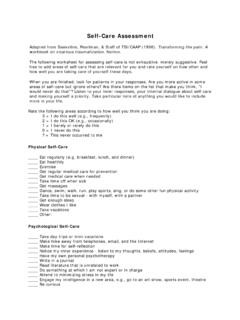Transcription of Tips for Starting a Support or Discussion Group
1 Tips for Starting a Support or Discussion Group Step One People After you have decided that you want to start a Support Group , identify two or three persons who share your interest in Starting (not simply joining) a Support Group . Although it is possible to run a Support Group by yourself, it is easier, and you reduce the chance of burn out if you have other people assisting you. If one of the people assisting you has a computer, that is an additional benefit, as they may be willing to maintain the mailing list, make flyers and print minutes and notices. Step Two Planning You will need to decide quite a number of things before the first meeting of your Group , such as the frequency, location and emphasis of the Group . Decide how often your Group will meet. If your Group meets less often than once a month, it runs the risk of losing momentum and focus; interest may die out in the long weeks before the next meeting.
2 Some groups may have the interest to meet more than once a month. If so, feel free to go with the interest, but don't feel that every two weeks is the norm. Many Starting groups meet only once a month and are quite successful. Decide how you will get the word out. Most people will have a list of people who would be interested in a Support or Discussion Group . What Kind of Group ? There are many kinds of Support groups. Each has its own style, and each speaks to people in different ways. You and the other people who are interested in Starting a Support Group probably already have the type of Support Group you want in mind. Major types of Support groups are as follows: Peer Support groups: Groups led by others with similar interests. Usually these groups are not led by a professional. A professionally led Support Group : These groups are led or advised by a professional like a social worker or psychologist. A Discussion Group : Not necessarily a Support Group , but a Group with an educational emphasis to it.
3 These groups may have a video or a speaker or topic each meeting. These groups may also provide a time where individuals can discuss issues of interest and concern to them to see if others have suggestions or have experienced a similar situation. Step Three Place Decide on a central location. The location should, of course be accessible, with plenty of parking and accessible via public transportation if possible. Don't forget to make sure the bathrooms are accessible. Some people may be tempted to have a rotating meeting place to make the meeting more accessible to people with transportation problems. This has benefits and potential problems. A benefit is that some people will have at least a few meetings in their area. This can increase the total number of people attending throughout the year. A potential problem is that the Group becomes fragmented because only certain people attend certain meetings. Also, unless the meeting locations are well publicized in advance, people may forget where the meeting is and decide not to attend.
4 With the same location, people always know where to go. Step Four Publicity Publicity is crucial to a beginning Support Group . It is important to leverage all available media (especially free outlet). Make up a flier announcing the meeting. You're not writing the great American novel here, so just give people the basics date, location, time, and a brief description of the purpose of the Group . Remember, if you're putting the flyer up in a public place you may have only 2 3 seconds to get a passerby's attention, so use large type and few words. Distribute the flyer to all the people on the mailing list. Step Five Programming So, what will you do in your meetings? If your meeting is strictly a Support Group meeting, you will want to go around and check in with everyone and then begin the meeting using whatever model you choose. If your meetings will have an educational component to them, then planning the meetings will require additional effort.
5 Plan a time for people to just hangout either before or after the meeting, and make sure that people don't leave without signing up with their address and telephone number. Not only does this keep your mailing list up to date, but it also allows your Support Group to grow. Running a meeting is learned skill, so don't feel discouraged if you're not perfect at it. It helps to have someone available who has done this before, so ask around. (Adapted from materials downloaded on 1/2/2010 from the National Spinal Cord Injury Resource Center info #Factsheet #18:)











